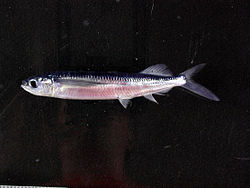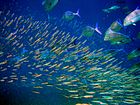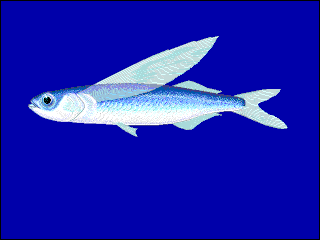
Beloniformes is an order composed of six families of freshwater and marine ray-finned fish:

Needlefish or long toms are piscivorous fishes primarily associated with very shallow marine habitats or the surface of the open sea. Some genera include species found in marine, brackish, and freshwater environments, while a few genera are confined to freshwater rivers and streams, including Belonion, Potamorrhaphis, and Xenentodon. Needlefish closely resemble North American freshwater gars in being elongated and having long, narrow jaws filled with sharp teeth, and some species of needlefishes are referred to as gars or garfish despite being only distantly related to the true gars. In fact, the name "garfish" was originally used for the needlefish Belone belone in Europe and only later applied to the North American fishes by European settlers during the 18th century.
Sauries are fish of the family Scomberesocidae. There are two genera, each containing two species. The name Scomberesocidae is derived from the scomber, which in turn is derived from the Greek skombros, meaning "mackerel", and the Latin esox meaning pike.
The ballyhoo halfbeak or ballyhoo is a baitfish of the halfbeak family (Hemiramphidae). It is similar to the Balao halfbeak in most features. Ballyhoo are frequently used as cut bait and for trolling purposes by saltwater sportsmen. The fish is reported to have caused ciguatera poisoning in humans.
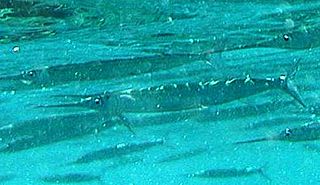
Hemiramphus is a genus of schooling marine fish commonly called halfbeaks, garfish, or ballyhoos, and are members of the family Hemiramphidae. They inhabit the surface of warm temperate and tropical sea, and feed on algae, plankton, and smaller fish. Hemiramphus species are edible but are more important as food fish for larger predatory species including dolphinfish and billfish.

Hyporhamphus ihi, the garfish or piper, is a halfbeak found all around New Zealand in shallow inshore waters.

The Balao halfbeak, occasionally called the Balao for short, is an ocean-going species of fish in the family Hemiramphidae. It was first described by the French naturalist Charles Alexandre Lesueur in 1821. They are used as cut bait and for trolling purposes by saltwater sportsmen.

Hyporhamphus is a genus of halfbeaks. The species in this genus are distributed throughout the warmer seas of the world, most species being Indo-Pacific and there are some freshwater species.
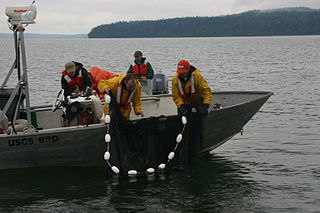
A lampara net is a type of fishing net. It is a surrounding net having the shape of a spoon or a dustpan with a short leadline under a longer floatline. The net has a central bunt to contain the fish and two lateral wings.
The short-beaked garfish is an uncommon species of needlefish in marine waters of the eastern Atlantic Ocean. This pelagic needlefish is present off the coasts of Ireland, Spain, Portugal, and the United Kingdom, and possibly in the Mediterranean Sea, as well. This species was thought to be the same as the garfish because they share the same waters. The short-beaked garfish matures at 30 cm (12 in) and can grow to a maximum of 65 cm (26 in) while Belone belone can be 95 cm (38 in). Like all needlefish, this one has an elongated body with beak-like jaws that are lined with razor sharp teeth. The short-beaked garfish's lower jaw is longer than the upper. Its body is silvery like most needlefish and has a black stripe running across its lateral line. The dorsal and anal fins are very close to the caudal peduncle. These fish are oviparous. Eggs may be found attached to objects in the water by tendrils on the egg's surface. These spherical eggs are dispersed on the sea floor (demersal). Not much is known about this fish's feeding habits. It likely preys on small oceangoing fish. It has been caught using mackerel. Needlefish tend to be surface fish, so are preyed upon like Atlantic mackerel, European pilchard, sand smelt, etc. The specific name honours Anatolii Nikolaevich Svetovidov (1903-1985) who was an ichthyologist at the Zoological Institute in Saint Petersburg, Russia and a colleague of N.V. Parin.

The American halfbeak, also known as Meek's halfbeak, is a halfbeak from the family Hemiramphidae.
Hyporhamphus collettei is a halfbeak from the family Hemiramphidae.
The black-tipped halfbeak, Hyporhamphus neglectissimus, is a halfbeak from the family Hemiramphidae.
The Congaturi halfbeak, also known as the Valenciennes halfbeak, is a potamodromous species of fish in the family Hemiramphidae. It is a valued commercial fish in tropical countries both dried salted and fresh forms.
The jumping halfbeak, is a reef-associated marine species of fish in the family Hemiramphidae. It is a valued commercial fish in tropical countries both dried salted and fresh forms.

Hemiramphus far, the halfbeak, black-barred halfbeak, black-barred garfish, barred halfbeak, barred garfish or spotted halfbeak, is a schooling marine fish in the family Hemiramphidae. It has an Indo-Pacific distribution and has invaded the eastern Mediterranean through the Suez Canal.
Hyporhamphus affinis, the tropical halfbeak, tropical garfish, insular halfbeak or coral reef halfbeak, is a species of schooling marine fish from the family Hemiramphidae. It is distributed through the Indo-Pacific regions and has been recorded in the Mediterranean Sea which it reached through the Suez Canal.
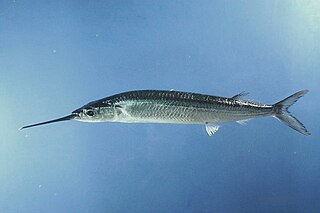
Hyporhamphus unifasciatus, the common halfbeak or the Atlantic silverstripe halfbeak, is a bony fish in the family Hemiramphidae. It is found in the subtropical western Atlantic Ocean and the Gulf of Mexico. It is a common fish and not used for food to any great extent, and the International Union for Conservation of Nature has listed its conservation status as being of "least concern".

Exocoetoidea is a superfamily of fishes that comprises three families, the flying fishes, the halfbeaks and the viviparous halfbeaks. They are found in tropical and subtropical waters around the world. Exocoetoidea is part of the suborder Exocoetoidei of the order Beloniformes.

Hyporhamphus melanochir, or Southern garfish or garfish, is a halfbeak garfish from the family Hemiramphidae. It is found in southern Australian and New Zealand waters. It is a very popular fish for recreational fishing and eating in Australia, where it is referred to simply as 'garfish' or 'gar'.

